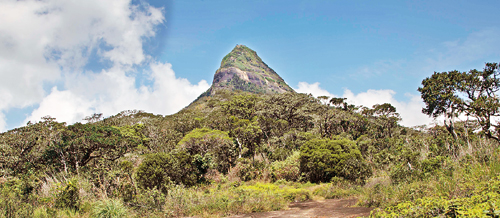Vesak, Upasampada and Sri Pada

Vesak Poya marks the conclusion of the Sri Pada season after six months
Vesak ‘Themagula’,the birth of Prince Siddhartha in Lumbini, Nepal, his Supreme Enlightenment in Bodhgaya in the state of Bihar and Maha Parinibbana in Kusinara in India is commemorated on Vesak Full Moon Poya.These are the three most important places of worship visited by Buddhists to pay homage to Gautama Buddha. On Vesak day, devotees in Sri Lanka observe both the aamisa pooja performing religious rituals and also prathipatti pooja by observing sil and meditation- sila, bhavana.
There are two other important events that take place in Sri Lanka on Vesak Full Moon Poya day. The Upasampada (higher ordination) of samanera (novice) monks begins with the Vesak Poya and the Sri Pada season ends after six months, on Vesak Full Moon Poya.
The Siamopali Mahavihara of Malwatte and Asgiriya Chapters commence their Upasampada with the dawn of the Vesak Poya in May and end on Poson Poya in June.
During the time of the Buddha there had been eight forms of conducting upasampada,the ehibhikkhuupasampada when the Buddha himself conferred Upasamada, Saranagamanupasampada,Ovadapatigahanupasampada, Pagnnabiyakaranupasampada, attagarudhanamapatiggahanupasampada, duthenauasampada, attavacika-upasampada,gnatchichathukamm-upasampada.
At present, only the eighth is followed. The samanera has to study for at least seven years in a school for monks which is known as a pirivena or under a upadyaya– a teacher who has to be a Maha Thera and has completed ten years of his upasampada,where the samanera resides. He can even have more than one teacher but at his upasampada only one is permitted to guide him. At the ceremony there will also be two Karmacharya who recite the karmavakya. A samanera has to complete 20 years of age to receive upasampada.
The Anunayake Thera of the Malwatte Chapter, the Most Ven. Dimbulkumbure Wimaladhamma Maha Thera said that this year the upasampada ceremonies will be conducted in a very simple manner. There are five poya days between Vesak and Poson. May 18th - Pasaloswaka, 26th – Atavaka, June 3rd – Amavaka- the darkest, June 10th - Puraatakavaka the rising moon and 16th – Pasalosvaka Full Moon. On these five poya days, two selected samanera will be recognized as ‘Wahala Naga’ from the Malwatte and Asgiriya temples.They will be dressed in a Thuppotiya and conducted to the Sri Dalada Maligawa on an elephant. During the time of the Kandyan kings, the king sponsored a samanera from each of the two temples. At present, continuing this tradition of Wahala Naga, the Diyawadana Nilame or in his absence the Kariya Karawana Korale will place a ‘crown’ similar to the one worn by the King of Siam on the Wahala Naga’s head and they are taken in a procession back to the Malwatte and Asgiriya temples, to complete the upasampada. The Most Ven. MahanayakeThera is the Upadyaya for the Wahala Naga.
The other important event on Vesak Poya is the conclusion of the Sri Pada season after six months. The season begins on Unduvap Full Moon Poya in December and ends with Vesak Full Moon Poya. Buddha had visited the mountain area on His third visit to Lanka, on an invitation by Sumana Saman, the guardian deity of Samanta Kuta. It is believed that He placed His footprint on the Samanala Kanda which is known as Sri Pada (resplendent feet). Hindus believe that it is Shiva’s footprint. Christians and Muslims also visit Adam’s Peak bringing religious amity.
Sri Pada can be reached from Ratnapura in the Sabaragamuwa Province and from the Nuwara Eliya district in the Central Province. It is possible to reach the peak by six routes. Ratnapura-Palabaddala, Kuruvita-Erathna, Murraywatte, Mookuwatte, Malimboda and through Nallathanni in Hatton which is the most popular and shorter route.
It takes more than five hours to reach the peak which is about 7360 feet in height. In Sanskrit texts it is known as Lanka Pabbatha, Rohana and Rohana Pabbatha. In the Mahawansa it is mentioned as Samantha Kuta - the abode of Saman Deiyo.
It is believed that King Walagamba, when he was driven away from his kingdom, lived in a forest for 14 years. Chasing a deer one day, he reached the summit of this mountain and discovered the sacred footprint.
During the off-season, the image of the deity Saman and other religious items are placed in the Galpotthawa Sripadasthana Viharaya in the Sabaragamuwa Province,where the incumbent monk is Ven. Bengamuwa Dhammadinna Maha Thera. Under the Thera’s guidance on the day before Unduvap Full Moon Poya in December, the image of the Saman deity and other items of worship are taken in a perahera (procession) to the Pelmadulla Raja Maha Viharya where pirith is chanted and religious rituals are performed before proceeding toSri Pada. There are three peraheras. One takes the route of Hatton-Nallathanni, the second Ratnapura-Palapaddala and the third through Balangoda across Pinnawala.They all meet at Sri Pada and after performing more rituals at the foot of the Samanala Kanda, reach the summit where the Saman deity’s image is placed.
At the end of the season, on Vesak Poya, after performing the same rituals the deity is returned to the Galpotthawa Viharaya.
With the intention of reaching the summit to view the sunrise,some pilgrims start their journey in the night. It is also less tiring, but they cannot enjoy the beauty of the surroundings in the night. Trekking up, the pilgrims make their ablutions at the Seetha gangula, a stream in which the water is icy-cold.On the way up to the mountain, you find the Sama Chaitya, the Peace Pagoda built in 1976. There are also small kiosks which offer food and drink.
The sunrise is spectacular. Pilgrims who reach the summit before dawn can view the sunrise which casts a shadow of the mountain in a conical shape on the opposite valley, which they call the ‘ira-seyawa.’
From June to November there are heavy rains and strong winds making it very difficult to climb the sacred mountain – hence it is the off-season for pilgrims.


